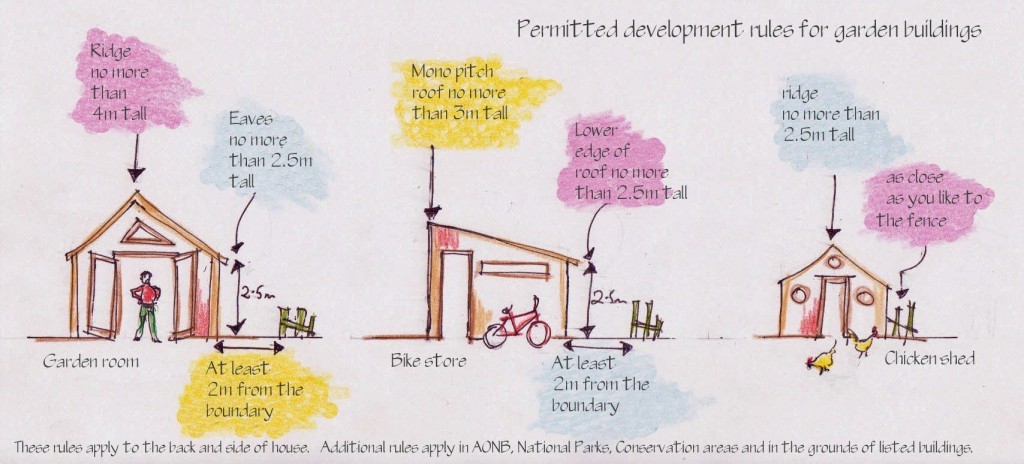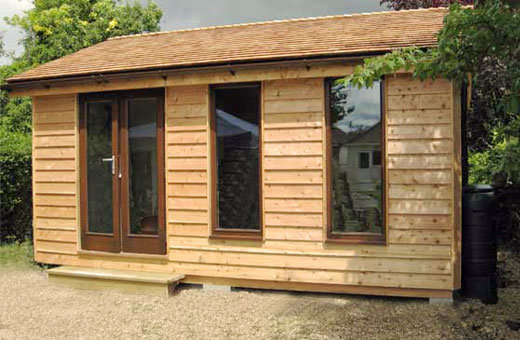Garden office planning permission is usually straight forward, and in some cases it’s unnecessary. In this definitive guide I will explain how to get the planning permission right without upsetting your local council or your neighbours.
Table of Contents
What can you build without planning permission?
Stay with me and I will explain. The two key factors that determine if you can build without planning permission are the height of the building and how you are going to use the building.
How tall is your building?
The maximum heights that you can build garden offices without planning permission have been developed to protect the interests of neighbours from shading, loss of light etc. there are various heights which relate to distance form the fence between you and your neighbour. See the following graphic:

(If you’re not a visual person there are written details at the bottom of this article.)
How are you going to use it?
When considering if your garden building needs planning permission you need to be clear in your own mind what you want to use it for:
Mine’s a shed
If it is a hut for chickens or a shed to keep the lawnmower in, it won’t be very tall and should fit into the “not needing planning permission if it’s under 2.5m tall” rule.
Mine’s an office
If you are going to use your building as a garden office and spend time in it every day you will need to consider two things:
You may be uncomfortable if it’s under 2.5m tall.
A building less than 2.5m tall isn’t tall enough to put a generous amount of insulation in the floor and ceiling to keep you warm in winter, cool in summer and leave enough headroom for you to be able to stand on tip toes or stretch your arms above your head.
How you use your garden office affects your permitted development rights.
If you are running a business eight hours a day, five days a week you may well need garden office planning permission even if the building is less than 2.5m tall. If you only occasionally work in your outdoor office you may not need permission, but more about that after…
This terrible tale…
A sad but avoidable tale of what happens if you don’t understand that permitted development is about how you use your building as well as about the building’s height was recounted in the Birmingham Mail on 29/10/10.
Gina Barton, a 42-year-old entrepreneur from Tamworth, Staffordshire decided to build a garden shed and convert it into a treatment room for her spray tan clients. What she didn’t realise was that, because she was regularly using the shed for business purposes and her clients were visiting her home, building a shed was not permitted development. It needed planning permission.
Gina said: “I was shocked when the planning officers came round and told me I had four months to take it down. I didn’t think I was doing anything wrong. I just didn’t realise it needed planning permission”
Councillor Steve Claymore, cabinet member for economic development and enterprise, said, “Planning officers were forced to act following complaints from neighbours. This council is keen to do all it can to help and support people who want to start up their own businesses. However, we cannot overlook the fact that we have had a number of complaints about the operation of this business, or the fact that it is operating without planning permission.
So, Gina had to stop working in her shed and look for more suitable premises.
NB. A business such as Gina’s in Tamworth had lots of visitors and so could have been disruptive to neighbours. If you work quietly in your office and won’t disturb the neighbours, getting planning permission to run your business in your garden office will be straight forward.
Mine’s a garden room or studio
 If your garden room or garden studio fits the permitted development sizes in our chart, then assuming that you are only using your garden room or studio for leisure purposes you may not need planning permission.
If your garden room or garden studio fits the permitted development sizes in our chart, then assuming that you are only using your garden room or studio for leisure purposes you may not need planning permission.
However, we had to apply for planning permission for the garden room opposite, even though it:
- Met all the permitted development size and position requirements
- Was only intended for leisure purposes and occasional work.
Why? Because the planning dept at Warwick Council were of the opinion that, because it had a toilet and was occasionally going to be used for working in it wasn’t an incidental building.
To understand permitted development you have to know what “incidental” means
Permitted development rules allow “incidental” buildings such as sheds and summerhouses to be put up without planning permission (as long as they are the correct height. See diagram above). A garden office or a garden studio used for leisure or occasionally used when working at home may well be viewed as “incidental” and hopefully won’t needing planning permission. Whereas a garden office used for business five days a week or a detached utility room plumbed for a washing machine etc may not be viewed as “incidental” by your local authority and they may want a planning application for it.
Note that I use the word “may” because each local authority interprets the permitted development rules differently. Plus, the government doesn’t provide a clear definition of what is an “incidental” building and what isn’t.
A rule of thumb given to me by a planning officer is that an “incidental” building contains things and activities that you wouldn’t keep in the house such as a summerhouse for enjoying the sun or a shed for wheelbarrows and chickens. Also studios, playrooms and summerhouses are usually viewed as incidental.
A garden building will always need planning permission if its primary use is as a bedroom or for obvious 24/7 business use.
So you can’t be sure your building is permitted development without checking with your local authority – unless it is definitely a garden shed that is either less than 2.5m tall or is more than 2.5m tall and positioned at least two metres from the boundary. (Full details on heights and boundaries below.)
If you build an office without planning permission and the council later decides that it needs planning permission, they will ask you to make a retrospective planning application. It is within their power to refuse the planning permission and make you take the building down.
Local authorities are essentially positive about garden offices and other garden buildings so, if you need planning permission you are highly likely to get it.
Focus on the office you want
So, what can we learn from all this?
That the best way to approach your new garden office is to decide what you want and where you want to put it and then if it needs planning permission, apply for it.
Why let a set of arbitrary rules dictate the size, design and comfort of your office or garden room?
At InsideOut we make planning applications at no extra charge for our clients, as an important part of our service. We have a 100% success rate. Getting planning permission for a garden building is rarely difficult. It typically takes eight weeks, which you may find frustrating, but it also takes time to double check with your local authority that you don’t need planning permission.
Permitted development – The rules for garden offices and other outbuildings:
Here are the permitted development rules for outbuildings in England and Wales. You will notice that outbuilding categories are vague and nowhere do the rules mention garden offices, garden rooms or any building that contains domestic plumbing: –
Rules governing outbuildings apply to sheds, greenhouses and garages as well as other ancillary garden buildings such as swimming pools, ponds, sauna cabins, kennels, enclosures (including tennis courts) and many other kinds of structure for a purpose incidental to the enjoyment of the dwelling house.
Outbuildings are considered to be permitted development and not needing planning permission, if they meet the following restrictions:
No outbuilding on land forward of a wall forming the principal elevation of the house.
Outbuildings to be single storey with maximum eaves height of 2.5 metres and maximum overall height of four metres with a dual pitched roof or three metres for any other roof.
Maximum height of 2.5 metres if within two metres of a boundary of the curtilage (garden) of the house.
No verandas, balconies or raised platforms.
No more than half the area of land around the “original house”* would be covered by additions or other buildings.
In National Parks, the Broads, Areas of Outstanding Natural Beauty and World Heritage Sites the maximum area to be covered by buildings, enclosures, containers and pools more than 20 metres from house to be limited to 10 square metres.
On designated land* buildings at the side of properties will require planning permission.
Within the curtilage of listed buildings any outbuilding will require planning permission.
Keep in mind that some houses, particularly on new build developments, may have had their permitted development rights removed as part of a planning condition.
Are you worried about needing planning permission for your garden office?
Below are four concerns that some people have about planning permission and why you don’t have to worry
I am worried the neighbours will complain
It is a democratic right for all of us to be able to complain about a planning application and lots of us do. In fact, it is unusual to find a planning application that doesn’t generate a comment or complaint.
Most comments and complaints are based upon fear and lack of understanding rather than unkindness or unreasonableness. Some people find it hard to visualise a building from two dimensional plans and others are frightened of change or having their privacy threatened.
Planning departments are used to dealing with complaints and they treat them with respect. But they also take your needs, as the applicant, and the merits of the building design very seriously.
If you are planning a garden building that’s:
- well designed
- built with good quality materials
- is in a sensible position in your garden
- isn’t too big for your garden
- if your building is to be used as an office – your work/ business is quiet and unobtrusive
Then your planning department is unlikely to uphold a neighbour’s complaint about your proposed office. But, if you want to build a large office right outside your neighbour’s windows or run a business that was noisy and had lots of visitors the planning department would rightly take your neighbour’s complaint seriously.
We’ve known neighbours complain about garden office planning permission applications, but once building work starts, they have lean’t over the garden wall and admitted that they were wrong and that the building looks really good.
Key points:
- It is important to consider the impact your building will have on your neighbours.
- It’s polite to show neighbours your proposed plans and explain to them what you intend to do, but you don’t have to do this if you don’t want to.
- Neighbours’ complaints are part and parcel of making a planning application, but, unless your application is unreasonable or unusual, their complaints are unlikely to have a major influence on the outcome of the application.
Our local planning department have a reputation for being unreasonable
This is an urban (or rural) rumour created by some peoples’ negative experiences of the planning system.
Most local councils have a design code that explains the type of development that they want to encourage in your area. Problems arise when householders are badly advised by builders and unqualified “designers”, or if they try to make a planning application themselves without understanding what is acceptable in planning terms and what isn’t.
Successful designs for houses, house extensions and garden offices require an architect’s input and skills. The architect’s job is to distil all the elements that constitute a successful building design so that the end result is right for your particular circumstance.
In our small architect’s practice it’s not unusual hear from people who have submitted a garden office planning application that has been turned down because of bad quality design and the planning department has advised the applicant to find a qualified architect to help them.
Key points:
- Planning departments turn down applications if they are inappropriate for your garden or neighbourhood.
- Planning departments turn down applications if they are badly designed.
- Planning departments are open and responsive to good quality, well thought out designs.
Getting garden office planning permission will take too long
A planning application typically takes two months to process. It has to be worth waiting this long to get the best garden office or other building for your purposes and have all the paperwork in place in case you want to sell your house in a few years time.
During the short wait for planning permission you will have time to plan fixtures and fittings and assess what you might want to do with the rest of the garden when the office has been built.
If don’t think you can wait for planning permission it’s possible that a garden office isn’t the right solution for you and that you need a short term rather than long term solution to your workspace problems.
Key points:
- If you have formal planning permission nobody can stop you building the office of your dreams.
- Building a garden office is as important a commitment as extending your house, so you will benefit from doing everything properly.
- Planning applications take 8 weeks.
I don’t think I’ll be lucky enough to get it
Planning permission doesn’t depend upon luck. It depends upon:
- good quality design
- well chosen building materials
- understanding planning legislation
I haven’t got time to get involved with the council and the paperwork
It is better to get involved with the council and obtain the correct planning permission now, rather than getting involved with them at a later date if someone complains because you have built your garden building without planning permission.
Summary
Planning permission is always the responsibility of the householder not the builder, so don’t believe anyone who tells you that you don’t need planning permission without doing an independent check.
You may need planning permission for your garden building – and you are highly likely to get it.
You may not need planning permission, but learn from Gina Barton’s mistakes and avoid disaster by checking with your local planning department.

